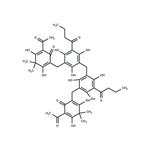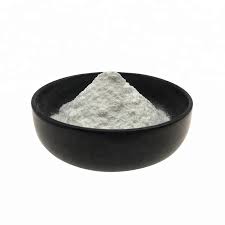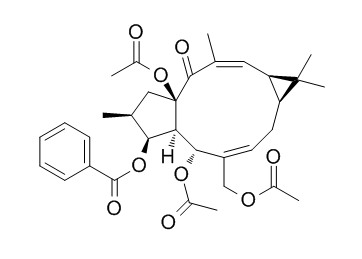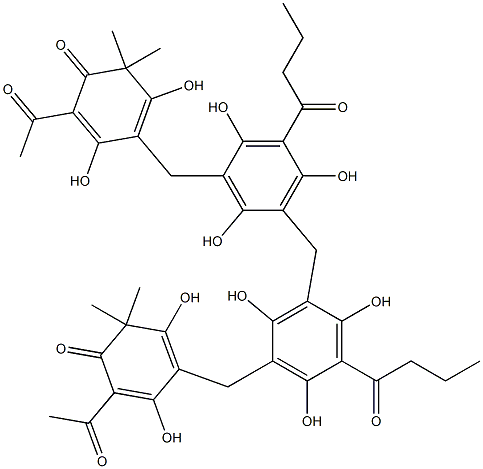Dryocrassin-- A new acylphloroglucinol from Dryopteris crassirhizoma
Feb 28,2020
Pharmacological Activities
Dryocrassin is a flavonoid natural product, a phloroglucinol derivative derived from Dryopteris crassirhizoma, with antiviral and antibacterial activities. Biological and pharmacological activities of dryocrassin have attracted attention. Dryocrassin exhibits antiviral activity against H5N1 avian influenza virus. Dryocrassin inhibits the coagulase activity of Staphylococcus aureus vWbp. Dryocrassin suppresses immunostimulatory function of dendritic cells and prolongs skin allograft survival.
Evaluation of Antiviral Activity of Dryocrassin
The occurrence of multi-drug resistant highly pathogenic avian influenza virus (HPAIV) strains highlights the urgent need for strategies for the prevention and control of avian influenza virus. To evaluate the antiviral activity of dryocrassin against an amantadine-resistant H5N1 strain, assay was conducted in a mouse model. Post inoculation with HPAIV H5N1 virus in mice, the survival rate was 87, 80, and 60% respectively in the 33, 18, and 12.5 mg/kg dryocrassin-treated groups. On the other hand, the survival rate was 53 and 20%, respectively in the amantadine-treated group and untreated group. Mice administered with dryocrassin or amantadine showed a significant weight increase compared to the untreated group. Moreover, 33 and 18 mg/kg dryocrassin have decreased lung index (P >0.05) and virus loads (P <0.01) compared to the untreated group on day 7. Also, on day 7 bronchoalveolar lavage fluid pro-inflammatory cytokines (IL-6, TNF-α, and IFN-γ) decreased significantly (P <0.01) while anti-inflammatory cytokines (IL-10 and MCP-1) were increased significantly (P <0.01) in the 33 and 18 mg/kg dryocrassin-treated groups compared to the amantadine group and the untreated group. Moreover, the concentrations of IL-12 in drug-treated groups were significantly (P < 0.01) lowered compared with the untreated group. Based on the above, orally administered dryocrassin provided mice protection against avian influenza virus H5N1 by inhibiting inflammation and reducing virus loads. Dryocrassin is a potential novel lead compound which had antiviral effects on amantadine-resistant avian influenza virus H5N1 infection.
Apoptotic Effect of Dryocrassin on Human Hepatocellular Carcinoma HepG2 Cells
This study was investigated by MTT, flow cytometry, real-time PCR, and Western blotting. KM male mice were used. Dryocrassin inhibited the growth of HepG2 cells in a concentration-dependent manner. After treatment with 25, 50, and 75 μg/mL dryocrassin, the cell viability was 68%, 60% and 49%, respectively. Dryocrassin was able to induce apoptosis, measured by propidium iodide (PI)/annexin V-FITC double staining. The results of real-time PCR and Western ting showed that dryocrassin up-regulated p53 and Bax expression and inhibited Bcl-2 expression which led to an activation of caspase-3 and caspase-7 in the cytosol, and then induction of cell apoptosis. In vivo experiments also showed that dryocrassin treatment significantly suppressed tumor growth, without major side effects. Overall, these findings provide evidence that dryocrassin ABBA may induce apoptosis in human hepatocellular carcinoma cells through a caspase-mediated mitochondrial pathway.

A sensitive and accurate liquid chromatography-tandem mass spectrometry method was developed and validated for the determination of dryocrassin in rat plasma. Chromatographic separation was achieved on a Zorbax SB-C18 column (50 × 2.1 mm, 1.8 µm), with elution consisting of eluent (A) 10 mm ammonium acetate in methanol containing 0.1% formic acid and (B) 10 mm ammonium acetate in water containing 0.1% formic acid (A:B = 99:1, v/v) at a flow rate of 0.3 mL/min. Multiple reaction monitoring mode was used to monitor the precursor-product ion transitions of m/z 819.3 → 403.4 for dryocrassin and m/z 426.2 → 409.2 for internal standard. This assay exhibited a good linearity with a correlation coefficient >0.99 and showed no endogenous interference with the analyte and internal standard. The lower limit of quantification of dryocrassin was 4 ng/mL in 50 μL of rat plasma. The method was successfully applied in the pharmacokinetic study of dryocrassin in rats after intravenous (2.35 mg/kg) and oral (23.5 mg/kg) doses of dryocrassin ABBA. The oral bioavailability (F) of dryocrassin was estimated to be 50.1%.
References
[1]. Ou C, et al. Dryocrassin ABBA, a novel active substance for use against amantadine-resistant H5N1 avian influenza virus. Front Microbiol. 2015, 6: 592.
[2]. Zhang B, et al. Molecular Mechanism of the Flavonoid Natural Product Dryocrassin ABBA against Staphylococcus aureus Sortase A. Molecules. 2016 Oct 26;21(11).
[3]. Li B, et al. An Inhibitory Effect of Dryocrassin ABBA on Staphylococcus aureus vWbp That Protects Mice from Pneumonia. Front Microbiol. 2019, 10: 7.
[4]. Fu RH, et al. Dryocrassin suppresses immunostimulatory function of dendritic cells and prolongs skin allograft survival. Cell Transplant. 2014;23(4-5): 641-56.
- Related articles
- Related Qustion
Deriving from seneciphylline, acetylseneciphylline N-oxide has a role as a Jacobaea metabolite. Structurally, it is an acetate ester, a macrocyclic lactone, an olefinic compound and an organic heterotricyclic compound.....
Feb 28,2020Inorganic chemistryEuphorbiasteroid, Euphorbia Factor L1 (EFL1) to be specific, with a tricyclic terpenoid skeleton, consisting of fused five-, eleven- and three-membered rings, is a diterpenoid isolated from the seeds of Euhporbia lathyris L.....
Feb 28,2020Plant extractsdryocrassin
12777-70-7You may like
- Synephrine: use,mechanism and risk assessment
Nov 3, 2025
- Pharmacology research of Genipin
Oct 15, 2025
- What are the Benefits of Malt Extract for the Humans?
Jul 31, 2025
- Dryocrassin ABBA
-

- $198.00 / 1mg
- 2025-12-05
- CAS:12777-70-7
- Min. Order:
- Purity: 98.92%
- Supply Ability: 10g
- dryocrassin
-

- $3.00 / 1KG
- 2020-01-18
- CAS:12777-70-7
- Min. Order: 1KG
- Purity: 98%
- Supply Ability: 1kg , 5kg, 50kg







